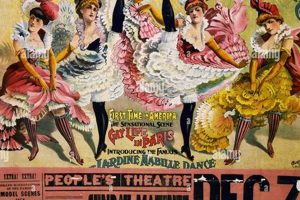Original promotional prints for animated films and television series from previous decades represent a niche collectible market. These items, often produced in limited quantities for theatrical releases or initial broadcast campaigns, showcase the artistic styles and character designs prevalent during their respective eras. An example includes a promotional print for the 1988 film “Akira,” featuring its distinctive cyberpunk aesthetic.
The significance of these collectibles lies in their historical context and artistic value. They provide a tangible link to the evolution of Japanese animation and offer insights into the cultural trends that shaped its development. Furthermore, these items represent significant investments for collectors, as their rarity and condition can influence their market value.
The following sections will explore the factors that contribute to the desirability of these collectibles, provide guidance on authenticating them, and offer practical tips for preservation and display.
Collecting and Preserving Vintage Anime Posters
Successful acquisition and long-term preservation of these collectibles require diligence and informed decision-making. The subsequent guidance aims to provide essential knowledge for navigating this specialized market.
Tip 1: Research Thoroughly Before Purchase: Investigate the specific title, production studio, and release year of the item. Consult reputable online databases and collector communities to verify information and establish baseline values. Avoid impulsive purchases based solely on visual appeal.
Tip 2: Authenticate the Item Carefully: Examine the printing quality, paper stock, and any discernible signs of reproduction. Compare the artifact against known authentic examples. Scrutinize for inconsistencies in typography, color, and resolution that may indicate a counterfeit.
Tip 3: Assess Condition Accurately: Evaluate the item for tears, creases, fading, staining, and other forms of damage. Understand that condition significantly impacts value. Minor imperfections are generally acceptable for older prints, but substantial damage reduces collectibility.
Tip 4: Store Appropriately: Utilize archival-quality materials for storage and display. Acid-free backing boards, mylar sleeves, and UV-protective glass are essential for preventing deterioration. Control environmental factors such as temperature, humidity, and light exposure.
Tip 5: Handle with Care: Always handle the artifact with clean, dry hands. Avoid bending, folding, or applying excessive pressure. When framing, ensure the print is properly mounted and supported to prevent sagging or warping.
Tip 6: Insure Your Collection: Obtain appropriate insurance coverage to protect against loss, damage, or theft. Regularly appraise the value of the collection and update insurance policies accordingly.
Tip 7: Seek Expert Advice: Consult with experienced collectors, appraisers, or art conservators for guidance on authentication, valuation, and preservation techniques. Leverage their expertise to make informed decisions and avoid costly mistakes.
Adherence to these recommendations enhances the likelihood of acquiring genuine items, preserving their condition, and maximizing their long-term value. Careful consideration of these factors is crucial for any serious enthusiast.
The concluding section will provide resources for further learning and connect collectors with relevant communities and professional organizations.
1. Rarity
Rarity serves as a cornerstone in the valuation of vintage promotional items from Japanese animated productions. The scarcity of a particular item directly correlates to its desirability and subsequent market value within collecting circles. Understanding the factors contributing to the limited availability of these materials is essential for both seasoned collectors and newcomers to the field.
- Limited Print Runs
Many were printed in restricted numbers for initial theatrical releases or television broadcast promotions. Unlike mass-produced merchandise, these items were often intended for internal distribution within studios or to select promotional partners. Consequently, survival rates for remain low, enhancing their scarcity.
- Regional Distribution
Some were produced exclusively for specific geographic markets, either within Japan or internationally. Differences in marketing strategies across regions resulted in varying quantities and designs, making those produced for smaller markets particularly difficult to obtain in the present day.
- Promotional Use Only
A significant portion were designed solely for display in theaters or distribution as promotional gifts, precluding general retail availability. These pieces, subjected to potential damage during use, are now scarce due to their intended disposability and limited lifespan.
- Accidental Loss or Destruction
Over time, original promotional prints are susceptible to loss, damage, or destruction. Improper storage, natural disasters, and simple neglect have reduced the overall population, making surviving examples increasingly rare and valuable.
In conclusion, rarity, stemming from limited production, regional specifics, promotional exclusivity, and attrition over time, exerts a dominant influence on the market. Collectors should consider these factors carefully when assessing the potential value and long-term investment potential of these pieces.
2. Condition
Condition is a primary determinant of value and desirability for vintage promotional materials. Its assessment involves careful scrutiny of physical attributes, directly influencing a collectible’s market appeal and long-term preservation prospects. Minor imperfections may be tolerated in extremely rare specimens, but overall condition remains a pivotal consideration.
- Paper Quality and Deterioration
The original paper stock and its present state are critical. Yellowing, foxing (brown spots caused by oxidation), brittleness, and tears diminish value. Archival-quality paper is ideal, while significant degradation negatively affects aesthetics and structural integrity, impacting a piece’s collectibility. Example: A print on fragile, low-quality paper exhibiting severe yellowing reduces its value substantially.
- Color Fading and Discoloration
Exposure to light, particularly UV radiation, causes colors to fade and shift. Original vibrant hues are highly desirable. Significant fading diminishes visual appeal and value. Discoloration from improper storage or handling also detracts from the item. An example is a promotional for a title like Sailor Moon, where vibrant color fidelity is crucial for retaining value; fading dramatically lowers the market price.
- Creases, Folds, and Wrinkles
Creases, folds, and wrinkles compromise the integrity and visual presentation. These imperfections often result from improper handling or storage. Severe creasing is often irreversible and reduces a piece’s desirability. An example would be a large crease running through a character’s face; this can significantly impact the price.
- Tears, Holes, and Edge Damage
Tears and holes represent physical damage that directly impacts the piece’s structural integrity and aesthetic appeal. Edge damage, such as fraying or missing sections, also detracts from value. Professional restoration may mitigate minor damage, but extensive damage significantly reduces collectibility. A tear that extends from the edge into the central image area would greatly diminish the worth.
The interplay of these factors determines a collectible’s overall state. Collectors prioritize items exhibiting minimal deterioration, vibrant colors, and structural soundness. Recognizing and accurately assessing the condition of such items requires both expertise and diligence. Maintaining the condition of collected examples demands adherence to proper storage and preservation techniques. The preservation of vintage promotional prints ensures continued enjoyment and value retention for future enthusiasts.
3. Authenticity
Verification of authenticity is paramount when acquiring vintage promotional materials from Japanese animation productions. The market for these collectibles is susceptible to reproductions, forgeries, and misrepresented items, necessitating diligent scrutiny to ensure the legitimacy of any potential purchase.
- Printing Techniques and Characteristics
Originals often exhibit specific printing methods and characteristics indicative of their era. Examination of dot patterns, color registration, and paper texture can reveal discrepancies suggesting a reproduction. For example, offset lithography was a common technique; modern digital prints lack the subtle imperfections inherent in older printing processes. Close inspection under magnification may reveal telltale signs of digital reproduction, such as perfectly uniform dot patterns.
- Copyright Markings and Studio Logos
Original promotional items typically bear copyright notices and studio logos corresponding to the production company and release year. Discrepancies in these markings, such as incorrect dates, misspelled names, or unfamiliar logos, raise red flags. Compare these markings to verified examples from reliable sources, such as studio archives or authoritative collector guides. An absence of these markings is also cause for suspicion.
- Paper Stock and Aging Characteristics
The type of paper used in original productions differs from modern alternatives. Vintage paper exhibits a natural aging process, often characterized by subtle yellowing, foxing, or a distinctive texture. Modern reproductions often utilize bright white, acid-free paper lacking these aging characteristics. Comparison with known examples and consultation with paper experts can aid in determining the age and composition of the paper stock.
- Size and Dimensions
Original promotional items adhere to specific size standards dictated by production and distribution requirements. Variations in size, even slight deviations from established norms, warrant careful investigation. Obtain measurements from reliable sources and compare them against the item in question. Discrepancies may indicate a resized reproduction or a composite created from multiple sources.
These authentication methods, while not exhaustive, provide a framework for assessing the legitimacy of vintage anime promotional prints. The increasing sophistication of reproduction techniques underscores the importance of ongoing research and collaboration with knowledgeable collectors and experts within the field. Careful attention to these details mitigates the risk of acquiring misrepresented or counterfeit items, ensuring that collectors obtain genuine pieces.
4. Artwork
The aesthetic qualities of these collectible items are integral to their value and appeal. The artistic style, composition, and character designs featured in these promotional prints directly influence their desirability among collectors. Distinct artwork, particularly those reflecting the signature styles of renowned animators or studios, elevates the collectible’s significance. For example, a piece showcasing the distinctive character designs of Hayao Miyazaki from an early Studio Ghibli film holds greater appeal than promotional material with generic artwork.
The artwork serves as a visual representation of the animated work, encapsulating its themes, tone, and overall aesthetic. The choice of colors, composition, and character portrayal contributes to the unique identity of each piece, making it more than mere advertising material. For instance, contrast the vibrant, dynamic style of a promotional print for Akira with the softer, more whimsical artwork of a My Neighbor Totoro print. This comparison highlights how the artwork embodies the essence of each animated production. Furthermore, the presence of key scenes or iconic characters directly contributes to a print’s desirability and subsequent market value.
Ultimately, the artwork on vintage promotional prints is not merely decorative; it is a crucial element driving collectibility. Its impact is multifaceted, encompassing artistic merit, historical context, and the embodiment of the animated work itself. The quality and uniqueness of the artwork directly influence value, underscoring its significance as a defining feature. Consequently, collectors and enthusiasts prioritize specimens exhibiting exceptional or representative artwork from acclaimed productions.
5. Provenance
The verifiable history of ownership, known as provenance, holds considerable influence on the valuation and desirability of vintage promotional material from Japanese animation. A well-documented provenance can significantly elevate an artifact’s worth, while a lack thereof introduces uncertainty and diminishes its appeal. This impact stems from the increased confidence in authenticity and the potential connection to notable individuals or institutions.
A clear chain of ownership, linking a piece to a former animator, studio executive, or significant collection, enhances its market value by providing assurance against forgery and implying a level of historical significance. For example, a promotional print for Space Battleship Yamato demonstrably originating from the personal collection of Leiji Matsumoto would command a premium due to its association with the series’ creator. Conversely, a print lacking any traceable history raises suspicion and requires more rigorous authentication efforts. The absence of provenance necessitates reliance on other, less conclusive factors, such as printing characteristics and paper analysis. Collectors should actively seek pieces with documented ownership histories, including bills of sale, exhibition records, or letters of provenance from credible sources. A well-documented origin story mitigates risk and reinforces the collectible’s inherent value.
Ultimately, provenance serves as a critical element in the equation, transforming a simple piece of printed material into a tangible link to the history of Japanese animation. While factors such as condition and artwork remain important, the presence of a robust and verifiable provenance provides an unparalleled level of confidence and enhances the intrinsic worth of vintage promotional prints. Collectors should prioritize documentation as a key criterion in their acquisitions.
6. Studio
The production studio responsible for an animated work significantly influences the collectibility and value of its vintage promotional prints. Certain studios have established a legacy of artistic innovation and cultural impact, imbuing items associated with their productions with a premium. This effect stems from the perceived quality, historical relevance, and enduring popularity of the animated series or films they created. Studio Ghibli, for instance, enjoys a widespread reputation for excellence in animation, thereby boosting the desirability of its vintage promotional materials. Another studio, like Toei Animation, possesses a long and storied history, with promotional prints from early series like Mazinger Z holding substantial historical significance. The studio name acts as a shorthand for a constellation of factors that drive collectibility, including production quality, character design, and narrative themes.
The impact of the studio extends beyond mere name recognition. The artistic style and thematic focus characteristic of particular studios affect the kind of collectors drawn to their vintage promotional items. For example, prints associated with Sunrise, known for its mecha anime, attract enthusiasts of that specific genre. Similarly, promotional material from Tatsunoko Production, with its distinctive character designs and innovative animation techniques, appeal to a distinct collector base. The studio affiliation provides information regarding the likely aesthetic and narrative qualities, influencing preferences and driving demand within niche collector markets. Also it is helpful to identify where to start, what kind of studio that is, so its easier for collector to dig more deep about their anime and related collectible item.
Understanding the connection between studio and collectibility empowers collectors to make informed decisions and focus their efforts effectively. Collectors can better assess the potential value and long-term investment potential of these prints by recognizing the influence of the production studio and researching its history and reputation. Knowledge of which studios produced landmark titles, innovated with animation techniques, and shaped the anime landscape is essential for navigating this nuanced market. Identifying a studio is a basic start for dig more deep regarding vintage anime posters.
Frequently Asked Questions
The following addresses common inquiries and misconceptions regarding the collecting, valuation, and preservation of original promotional prints for Japanese animated works.
Question 1: What distinguishes an “original” vintage example from a reproduction?
Originals typically exhibit specific printing techniques, paper characteristics, and copyright markings indicative of their era. Examination under magnification and comparison with verified examples are crucial for authentication. Reproductions often lack the subtle imperfections and aging characteristics of originals.
Question 2: How significantly does condition affect the value?
Condition is a primary determinant of value. Tears, creases, fading, and other forms of damage diminish collectibility. Items in near-mint condition command a premium, while those with substantial damage are significantly devalued.
Question 3: Is it possible to repair or restore damaged specimens?
Professional restoration can mitigate minor damage, such as small tears or surface dirt. However, extensive damage or irreversible degradation reduces the item’s intrinsic value, even after restoration. Attempting repairs without specialized knowledge can cause further harm.
Question 4: What are the optimal storage conditions for preservation?
Optimal storage involves the use of archival-quality materials, such as acid-free backing boards and mylar sleeves. Environmental control is essential, including maintaining stable temperature and humidity levels and minimizing exposure to light, particularly UV radiation.
Question 5: How does one determine the fair market value of such a collectible?
Fair market value is influenced by rarity, condition, artwork, provenance, and the reputation of the production studio. Consulting reputable online databases, auction records, and expert appraisers provides guidance. Establishing an accurate valuation requires thorough research and careful assessment of relevant factors.
Question 6: Are certain studios or series more sought after by collectors?
Indeed. Studio Ghibli, Sunrise, and Toei Animation hold prominence due to their historical significance and artistic contributions to the medium. Titles such as Akira, Space Battleship Yamato, and Mobile Suit Gundam are frequently sought after due to their cultural impact and lasting popularity.
These insights underscore the importance of careful research, diligent authentication, and proper preservation techniques when engaging with the market for original promotional prints for Japanese animation. Understanding these aspects facilitates informed decision-making and contributes to the long-term appreciation of these valuable artifacts.
The subsequent section offers additional resources for further learning and engagement within this specialized area of collecting.
Conclusion
This exploration has illuminated critical factors influencing the market for promotional prints from Japanese animated productions. Rarity, condition, authenticity, artwork, provenance, and the production studio each exert considerable influence on valuation and collectibility. Diligent research, careful authentication, and proper preservation are imperative for successful acquisition and long-term appreciation within this specialized niche.
Continued study of historical context, printing techniques, and artist contributions will further enhance the ability to navigate this market effectively. The enduring appeal of these artifacts underscores their cultural significance and enduring value as tangible representations of the history of Japanese animation. Vigilance and informed decision-making remain essential for both seasoned collectors and newcomers alike.







